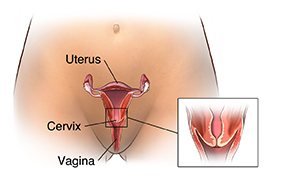Cervical Cancer: Introduction
What is cancer?
Cancer starts when cells in the body change and grow out of control. To help you understand
what happens when you have cancer, let's look at how your body works normally. Your
body is made up of tiny building blocks called cells. Normal cells grow when your
body needs them, and they die when your body doesn't need them any longer.
Cancer is made up of abnormal cells that grow even though your body doesn't need them.
In most cancers, the abnormal cells grow to form a lump or mass called a tumor. If
cancer cells are in the body long enough, they can grow into (invade) nearby areas.
They can even spread to other parts of the body (metastasis).
What is cervical cancer?
Cancer that starts in cells of the cervix is called cervical cancer.
Understanding the cervix
The cervix is the lower, narrow part of the uterus. It connects the uterus to the
birth canal (vagina), which leads to the outside of the body. It's between the bladder
and the rectum.

Looking for precancer
Precancer cells on the cervix are the first sign that cervical cancer may develop.
These cells can be seen on a Pap test. They're cells that look abnormal, but they
are not yet cancer. Finding these cells may be the first sign of cancer that will
grow years later. Treating these precancer cells can prevent cancer from forming.
Precancer cells of the cervix seldom cause pain or other symptoms. This is why regular
cervical cancer screening with Pap tests is so important.
Types of precancer
Squamous intraepithelial lesion (SIL), dysplasia, and cervical intraepithelial neoplasia
(CIN) are terms that refer to abnormal changes in the cells on the surface of the
cervix. These changes can be found with a Pap test.
SIL is divided into 2 categories:
-
Low-grade SIL. This refers to early changes in the size, shape, and number of cells that form the
surface of the cervix. The changes may go away on their own over time. Or they may
grow larger or become more abnormal, forming a high-grade lesion. These changes may
also be called mild dysplasia or CIN 1.
-
High-grade SIL. This means there are a large number of seriously changed cells that are precancer
cells. Like low-grade SIL, these changes only happen in cells on the surface of the
cervix. The cells often don’t become cancer for many months, or even many years. But
without treatment, they will become cancer. High-grade SIL may also be called moderate
or severe dysplasia, CIN 2 or 3, or carcinoma in situ.
If abnormal cells on the surface of the cervix are not found and treated, over time
they can spread deeper into the cervix or spread to other tissues or organs. This
is then called cervical cancer, or invasive cervical cancer. Cervical cancer occurs
most often in women younger than age 50. Most cervical cancers are either squamous
cell carcinomas or adenocarcinomas.
The death rate for cervical cancer has dropped sharply as Pap screenings have become
more prevalent. Today, most cervical cancer is usually found in women who have not
had regular screenings, and in women who have not had any screenings.
Preventing cervical cancer
Cervical cancer is 1 of the few kinds of cancer that healthcare providers know how
to prevent. There are 2 key ways to prevent cervical cancer:
-
Get regular Pap tests. These are done to find and treat any precancer cells as soon as possible, before
they can change into true cancer.
-
Prevent precancer cells. You can do this by preventing infection with the human papillomavirus (HPV), getting
an HPV vaccine, and not smoking.
Talk with your healthcare provider
If you have questions about cervical cancer, cervical cancer screening, or ways to
prevent cervical cancer, talk with your healthcare provider. Your provider can help
you understand more about this cancer.